 W
WAlexander II was a king of Epirus, and the son of Pyrrhus and Lanassa, the daughter of the Sicilian tyrant Agathocles.
 W
WLucius Livius Andronicus was a Greco-Roman dramatist and epic poet of the Old Latin period. He began as an educator in the service of a noble family at Rome by translating Greek works into Latin, including Homer's Odyssey. They were meant at first as educational devices in the school he founded. He wrote works for the stage—both tragedies and comedies—which are regarded as the first dramatic works written in the Latin language of ancient Rome. His comedies were based on Greek New Comedy and featured characters in Greek costume. Thus, the Romans referred to this new genre by the term comoedia palliata. The Roman biographer Suetonius later coined the term "half-Greek" of Livius and Ennius. The genre was imitated by the next dramatists to follow in Andronicus' footsteps and on that account he is regarded as the father of Roman drama and of Latin literature in general; that is, he was the first man of letters to write in Latin. Varro, Cicero, and Horace, all men of letters during the subsequent Classical Latin period, considered Livius Andronicus to have been the originator of Latin literature. He is the earliest Roman poet whose name is known.
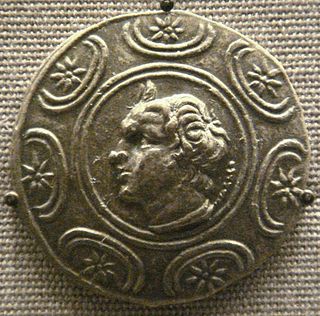 W
WAntigonus II Gonatas was a Macedonian ruler who solidified the position of the Antigonid dynasty in Macedon after a long period defined by anarchy and chaos and acquired fame for his victory over the Gauls who had invaded the Balkans.
 W
WAntigonus III Doson was king of Macedon from 229 BC to 221 BC. He was a member of the Antigonid dynasty.
 W
WAratus was a Greek didactic poet. His major extant work is his hexameter poem Phenomena, the first half of which is a verse setting of a lost work of the same name by Eudoxus of Cnidus. It describes the constellations and other celestial phenomena. The second half is called the Diosemeia, and is chiefly about weather lore. Although Aratus was somewhat ignorant of Greek astronomy, his poem was very popular in the Greek and Roman world, as is proved by the large number of commentaries and Latin translations, some of which survive.
 W
WAratus of Sicyon was a politician and military commander of Hellenistic Greece. He was elected strategos of the Achaean League 17 times, leading the League through numerous military campaigns including the Cleomenean War and the Social War.
 W
WArcesilaus was a Greek Hellenistic philosopher. He was the founder of Academic Skepticism and what is variously called the Second or Middle or New Academy—the phase of the Academy in which it embraced philosophical skepticism.
 W
WArchimedes of Syracuse was a Greek mathematician, physicist, engineer, inventor, and astronomer. Although few details of his life are known, he is regarded as one of the leading scientists in classical antiquity. Considered to be the greatest mathematician of ancient history, and one of the greatest of all time, Archimedes anticipated modern calculus and analysis by applying concepts of infinitesimals and the method of exhaustion to derive and rigorously prove a range of geometrical theorems, including: the area of a circle; the surface area and volume of a sphere; area of an ellipse; the area under a parabola; the volume of a segment of a paraboloid of revolution; the volume of a segment of a hyperboloid of revolution; and the area of a spiral.
 W
WAristarchus of Samos was an ancient Greek astronomer and mathematician who presented the first known heliocentric model that placed the Sun at the center of the known universe with the Earth revolving around it. He was influenced by Philolaus of Croton, but Aristarchus identified the "central fire" with the Sun, and he put the other planets in their correct order of distance around the Sun. Like Anaxagoras before him, he suspected that the stars were just other bodies like the Sun, albeit farther away from Earth. His astronomical ideas were often rejected in favor of the geocentric theories of Aristotle and Ptolemy. Nicolaus Copernicus attributed the heliocentric theory to Aristarchus.
 W
WArsinoe I was queen of Egypt by marriage to Ptolemy II Philadelphus.
 W
WArsinoe III Philopator was Queen of Egypt in 220 – 204 BC. She was a daughter of Ptolemy III and Berenice II. She was the first Ptolemaic queen to bear her own brother's child. Arsinoe and her spouse Ptolemy IV were loved and well respected by the Egyptian public.
 W
WAttalus I, surnamed Soter ruled Pergamon, an Ionian Greek polis, first as dynast, later as king, from 241 BC to 197 BC. He was the first cousin once removed and the adoptive son of Eumenes I, whom he succeeded, and was the first of the Attalid dynasty to assume the title of king in 238 BC. He was the son of Attalus and his wife Antiochis.
 W
WAutolycus of Pitane was a Greek astronomer, mathematician, and geographer. The lunar crater Autolycus was named in his honour.
 W
WBerenice II Euergetis was ruling queen of Cyrenaica from around 250 BC and queen and co-regent of Ptolemaic Egypt from 246 BC to 222 BC as the wife of Ptolemy III Euergetes.
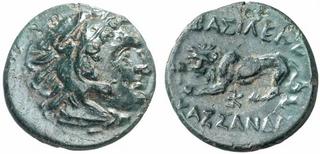 W
WCassander was king of the ancient kingdom of Macedon from 305 BC until 297 BC, and de facto ruler of southern Greece from 317 BC until his death.
 W
WChrysippus of Soli was a Greek Stoic philosopher. He was a native of Soli, Cilicia, but moved to Athens as a young man, where he became a pupil of Cleanthes in the Stoic school. When Cleanthes died, around 230 BC, Chrysippus became the third head of the school. A prolific writer, Chrysippus expanded the fundamental doctrines of Zeno of Citium, the founder of the school, which earned him the title of Second Founder of Stoicism.
 W
WCleanthes, of Assos, was a Greek Stoic philosopher and successor to Zeno of Citium as the second head (scholarch) of the Stoic school in Athens. Originally a boxer, he came to Athens where he took up philosophy, listening to Zeno's lectures. He supported himself by working as a water-carrier at night. After the death of Zeno, c. 262 BC, he became the head of the school, a post he held for the next 32 years. Cleanthes successfully preserved and developed Zeno's doctrines. He originated new ideas in Stoic physics, and developed Stoicism in accordance with the principles of materialism and pantheism. Among the fragments of Cleanthes' writings which have come down to us, the largest is a Hymn to Zeus. His pupil was Chrysippus who became one of the most important Stoic thinkers.
 W
WDicaearchus of Messana, also written Dicearchus or Dicearch, was a Greek philosopher, cartographer, geographer, mathematician and author. Dicaearchus was Aristotle's student in the Lyceum. Very little of his work remains extant. He wrote on the history and geography of Greece, of which his most important work was his Life of Greece. He made important contributions to the field of cartography, where he was among the first to use geographical coordinates. He also wrote books on philosophy and politics.
 W
WEpicurus was an ancient Greek philosopher and sage who founded Epicureanism, a highly influential school of philosophy. He was born on the Greek island of Samos to Athenian parents. Influenced by Democritus, Aristippus, Pyrrho, and possibly the Cynics, he turned against the Platonism of his day and established his own school, known as "the Garden", in Athens. Epicurus and his followers were known for eating simple meals and discussing a wide range of philosophical subjects. He openly allowed women to join the school as a matter of policy. Epicurus is said to have originally written over 300 works on various subjects, but the vast majority of these writings have been lost. Only three letters written by him—the letters to Menoeceus, Pythocles, and Herodotus—and two collections of quotes—the Principal Doctrines and the Vatican Sayings—have survived intact, along with a few fragments of his other writings. Most knowledge of his teachings comes from later authors, particularly the biographer Diogenes Laërtius, the Epicurean Roman poet Lucretius and the Epicurean philosopher Philodemus, and with hostile but largely accurate accounts by the Pyrrhonist philosopher Sextus Empiricus, and the Academic Skeptic and statesman Cicero.
 W
WErasistratus was a Greek anatomist and royal physician under Seleucus I Nicator of Syria. Along with fellow physician Herophilus, he founded a school of anatomy in Alexandria, where they carried out anatomical research. As well, he is credited with helping to found the methodic school of teachings of medicine in Alexandria whilst opposing traditional humoral theories of Hippocratic ideologies. Together, with Herophilus, is credited by historians as the potential founder of neuroscience due to his acknowledgements of nerves and their roles in motor control through the brain and skeletal muscles. Furthermore, Erasistratus is seen as one of the first physicians/scientists to conduct recorded dissections and potential vivisections alongside Herophilus. The two physicians were said by several Roman authors, notably Augustine, Celsus, and Tertullian, to have controversially performed vivisections on criminals to study the anatomy and possible physiology of human organs while they were in Alexandria. Because of their research, Erasistratus and Herophilus were heavily criticized for their utilization of vivisections specifically, namely the author Tertullian who followed Christian values. Erasistratus and Herophilus are thought to be the first physicians to perform dissections on the human body systematically until the Renaissance. He is credited for his description of the valves of the heart, and he also concluded that the heart was not the center of sensations, but instead it functioned as a pump. Erasistratus was among the first to distinguish between veins and arteries. He believed that the arteries were full of air and that they carried the "animal spirit" (pneuma). He considered atoms to be the essential body element, and he believed they were vitalized by the pneuma that circulated through the nerves. He also thought that the nerves moved a nervous spirit from the brain. He then differentiated between the function of the sensory and motor nerves, and linked them to the brain. He is credited with one of the first in-depth descriptions of the cerebrum and cerebellum.
 W
WEratosthenes of Cyrene was a Greek polymath: a mathematician, geographer, poet, astronomer, and music theorist. He was a man of learning, becoming the chief librarian at the Library of Alexandria. His work is comparable to what is now known as the study of geography, and he introduced some of the terminology still used today.
 W
WEuclid, sometimes called Euclid of Alexandria to distinguish him from Euclid of Megara, was a Greek mathematician, often referred to as the "founder of geometry" or the "father of geometry". He was active in Alexandria during the reign of Ptolemy I. His Elements is one of the most influential works in the history of mathematics, serving as the main textbook for teaching mathematics from the time of its publication until the late 19th or early 20th century. In the Elements, Euclid deduced the theorems of what is now called Euclidean geometry from a small set of axioms. Euclid also wrote works on perspective, conic sections, spherical geometry, number theory, and mathematical rigour.
 W
WEumenes I was dynast (ruler) of the city of Pergamon in Asia Minor from 263 BC until his death in 241 BC. He was the son of Eumenes, the brother of Philetaerus, the founder of the Attalid dynasty, and Satyra, daughter of Poseidonius. As he had no children, Philetaerus adopted Eumenes to become his heir.
 W
WHermarchus or Hermarch, sometimes incorrectly written Hermachus, was an Epicurean philosopher. He was the disciple and successor of Epicurus as head of the school. None of his writings survive. He wrote works directed against Plato, Aristotle, and Empedocles. A fragment from his Against Empedocles, preserved by Porphyry, discusses the need for law in society. His views on the nature of the gods are quoted by Philodemus.
 W
WHerodas, or Herondas, was a Greek poet and the author of short humorous dramatic scenes in verse, probably written in Alexandria during the 3rd century BC.
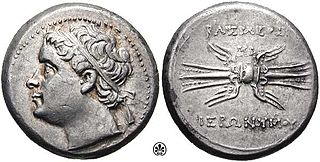 W
WHieronymus was a tyrant of Syracuse. He succeeded his grandfather, Hiero II, in 215 BC. He was at this time only fifteen years old, and he ascended the throne at a crisis full of peril, for the Battle of Cannae had given a shock to the Roman power, the influence of which had been felt in Sicily; and though it had not shaken the fidelity of the aged Hiero, yet a large party at Syracuse was already disposed to abandon the alliance of Rome for that of Carthage. The young prince had already given indications of weakness, if not depravity of disposition, which had alarmed his grandfather, and caused him to confide the guardianship of Hieronymus to a council of fifteen persons, among whom were his two sons-in-law, Andranodorus and Zoippus. But the objects of this arrangement were quickly frustrated by the ambition of Andranodorus, who, in order to get rid of the interference of his colleagues, persuaded the young king to assume the reins of government, and himself set the example of resigning his office, which was followed by the other guardians. Hieronymus now became a mere tool in the hands of his two uncles, both of whom were favourable to the Carthaginian alliance – and Thrason, the only one of his counsellors who retained any influence over his mind, and who was a staunch friend of the Romans, was soon got rid of by a charge of conspiracy.
 W
WLyco of Troas, son of Astyanax, was a Peripatetic philosopher and the disciple of Strato, whom he succeeded as the head of the Peripatetic school, c. 269 BC; he held that post for more than forty-four years.
 W
WMetrodorus of Lampsacus was a Greek philosopher of the Epicurean school. Although one of the four major proponents of Epicureanism, only fragments of his works remain. A Metrodorus bust was found in Velia, slightly different modeled to depict Parmenides.
 W
WNicomedes was an ancient Greek mathematician.
 W
WNicomedes I, second king of Bithynia, was the eldest son of Zipoetes I, whom he succeeded on the throne in 278 BC.
 W
WPhilip V was king (Basileus) of the ancient Greek Kingdom of Macedonia from 221 to 179 BC. Philip's reign was principally marked by an unsuccessful struggle with the emerging power of the Roman Republic. He would lead Macedon against Rome in the First and Second Macedonian Wars, losing the latter but allying with Rome in the Roman-Seleucid War towards the end of his reign.
 W
WPhilitas of Cos, sometimes spelled Philetas, was a scholar and poet during the early Hellenistic period of ancient Greece. A Greek associated with Alexandria, he flourished in the second half of the 4th century BC and was appointed tutor to the heir to the throne of Ptolemaic Egypt. He was thin and frail; Athenaeus later caricatured him as an academic so consumed by his studies that he wasted away and died.
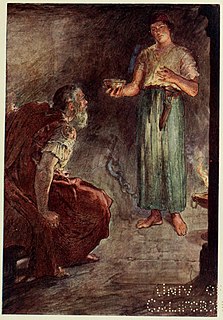 W
WPhilopoemen was a skilled Greek general and statesman, who was Achaean strategos on eight occasions.
 W
WPtolemy I Soter was a companion and historian of Alexander the Great of the Kingdom of Macedon in northern Greece who became ruler of Egypt, part of Alexander's former empire. Ptolemy was pharaoh of Ptolemaic Egypt from 305/304 BC to his death. He was the founder of the Ptolemaic dynasty which ruled Egypt until the death of Cleopatra in 30 BC, turning the country into a Hellenistic kingdom and Alexandria into a center of Greek culture.
 W
WPyrrho of Elis was a Greek philosopher of Classical antiquity and is credited as being the first Greek skeptic philosopher and founder of Pyrrhonism.
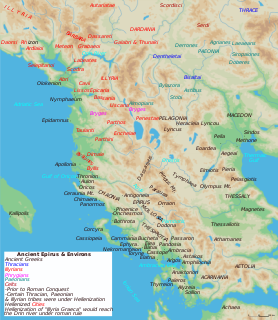 W
WPyrrhus II was the son of Olympias II and Alexander II of Epirus. He was a brother of Ptolemy and Phthia of Macedon. He ruled as king of Epirus from 242 BC to 237 BC. He had two daughters: Deidamia II who was the last ruler of the Aeacid Dynasty and Nereis who married Gelon of Syracuse.
 W
WPyrrhus was a Greek king and statesman of the Hellenistic period. He was king of the Greek tribe of Molossians, of the royal Aeacid house, and later he became king of Epirus. He was one of the strongest opponents of early Rome. Several of his victorious battles caused him unacceptably heavy losses, from which the term Pyrrhic victory was coined.
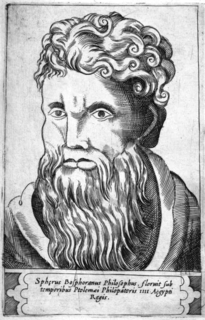 W
WSphaerus of Borysthenes or the Bosphorus, was a Stoic philosopher.
 W
WStrato of Lampsacus was a Peripatetic philosopher, and the third director (scholarch) of the Lyceum after the death of Theophrastus. He devoted himself especially to the study of natural science, and increased the naturalistic elements in Aristotle's thought to such an extent, that he denied the need for an active god to construct the universe, preferring to place the government of the universe in the unconscious force of nature alone.
 W
WTheocritus was a Sicilian poet and the creator of Ancient Greek pastoral poetry.
 W
WTheophrastus, a Greek native of Eresos in Lesbos, was the successor to Aristotle in the Peripatetic school. His given name was Tyrtamus (Τύρταμος); his nickname Θεόφραστος was given by Aristotle for his 'divine style of expression'.
 W
WTimon of Phlius was a Greek Pyrrhonist philosopher, a pupil of Pyrrho, and a celebrated writer of satirical poems called Silloi (Σίλλοι). He was born in Phlius, moved to Megara, and then he returned home and married. He next went to Elis with his wife, and heard Pyrrho, whose tenets he adopted. He also lived on the Hellespont, and taught at Chalcedon, before moving to Athens, where he lived until his death. His writings were said to have been very numerous. He composed poetry, tragedies, satiric dramas, and comedies, of which very little remains. His most famous composition was his Silloi, a satirical account of famous philosophers, living and dead; a spoudaiogeloion in hexameter verse. The Silloi has not survived intact, but it is mentioned and quoted by several ancient authors. It has been suggested that Pyrrhonism ultimately originated with Timon rather than Pyrrho.
 W
WTushaspha was a "Yavanaraja" for Emperor Ashoka, in the area of Girnar, near Junagadh, in Gujarat, India. He is only know from the Junagadh rock inscription of Rudradaman, in which the Western Satrap king Rudradaman, writing circa 150 CE, mentions his role in the construction of a local dam, in which he added a canal during the reign of Ashoka. The part of the inscription mentioning him reads:"(L.8) ordered to be made by the Vaishya Pushyagupta, the provincial governor of the Maurya king Chandragupta; adorned with conduits for Ashoka the Maurya by the Yavana king Tushaspha while governing; and by the conduit ordered to be made by him, constructed in a manner worthy of a king (and) seen in that breach, the extensive dam ..."
 W
WZeno of Citium was a Hellenistic philosopher of Phoenician origin from Citium, Cyprus. Zeno was the founder of the Stoic school of philosophy, which he taught in Athens from about 300 BC. Based on the moral ideas of the Cynics, Stoicism laid great emphasis on goodness and peace of mind gained from living a life of Virtue in accordance with Nature. It proved very popular, and flourished as one of the major schools of philosophy from the Hellenistic period through to the Roman era, and enjoyed revivals in the Renaissance as Neostoicism and in the current era as Modern Stoicism.